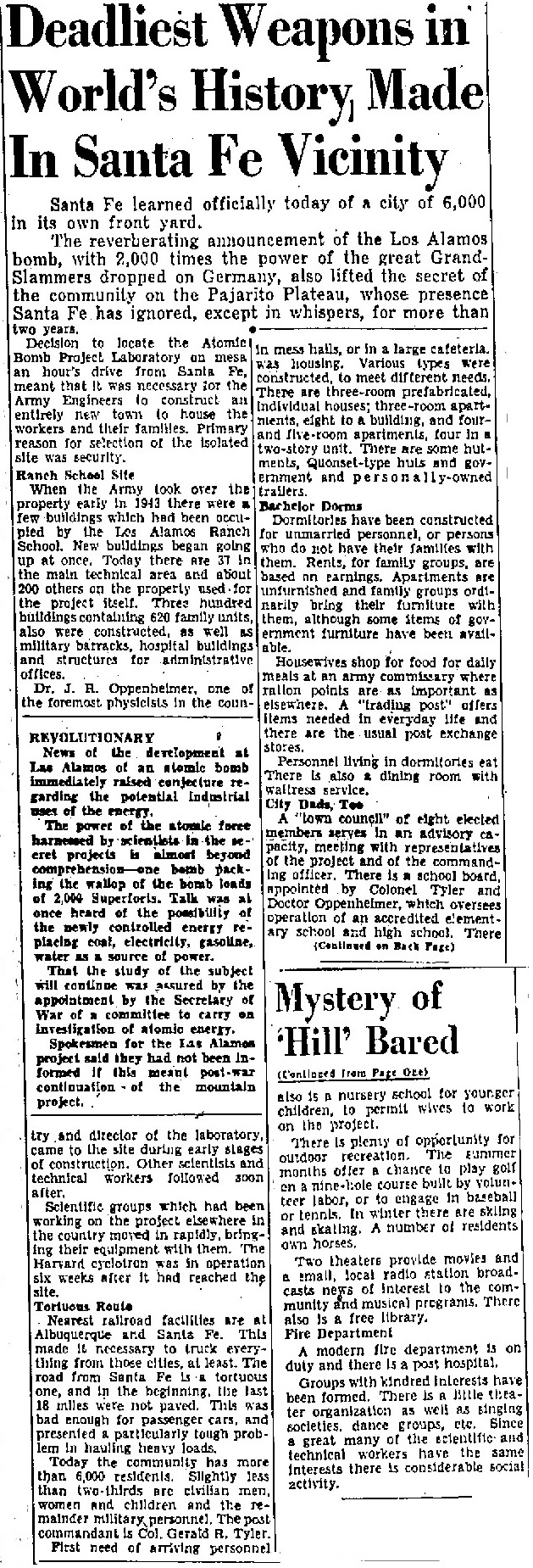In this article published on August 6, 1945, the same day the atomic bomb was dropped on Hiroshima, Santa Fe first learns of a secret town of 6,000 residents located at the site of the Los Alamos Ranch School on the Pajarito Plateau. The new town of “Los Alamos” is described.
Very similar articles were published on the same day in two other communities in the United States. Where were they and why?
| Document Type: | Newspaper Article |
| Historical Event: | New Mexico Role in WW II (1941-45) |
| Sub Event: | Manhattan Project |
| Origin: | Santa Fe New Mexican |
| Date: | August 6, 1945 |
| Author: | Not Sited |
| Permission: | Fair Use |
| Contributor: | Dan Jones |

Digital Text:
The Santa Fe New Mexican
August 6,1945
Deadliest Weapons in World's History, Made In Santa Fe Vicinity
Santa Fe learned officially today of a city of 6,000 in its own front yard.
The reverberating announcement of the Los Alamos bomb, with 2,000 times the power of the great Grand-Slammers dropped on Germany, also lifted the secret of the community on the Pajarito Plateau, whose presence Santa Fe has ignored, except in whispers, for more than two years.
Decision to locate the Atomic Bomb Project Laboratory on mesa an hour's drive front Santa Fe, meant that it was necessary for the Army Engineers to construct an entirely new town to house the workers and their families. Primary reason for selection of the isolated site was security.
Ranch School Site
When the Army took over the property early in 1943 there were a few buildings which had been occupied by the Los Alamos Ranch School. New buildings began going up at once. Today there are 37 in the main technical area and about 200 others on the property used for the project itself. Three hundred buildings containing 620 family units, also were constructed, as well as military barracks, hospital buildings and structures for administrative offices.
Dr. J. R. Oppenheimer, one of the foremost physicists In the country and director of the laboratory, came to the site during early stages of construction. Other scientists and technical workers followed soon after.
Scientific groups which had been working on the project elsewhere in the country moved in rapidly, bringing their equipment with them. The Harvard cyclotron was in operation six weeks after it had reached the site.
Tortuous Route
Nearest railroad facilities are at Albuquerque and Santa Fe. This made It necessary to truck every-thing from those cities, at least. The road from Santa Fe is a tortuous one, and in the beginning, the last 18 miles were not paved. This was bad enough for passenger cars, and presented a particularly tough problem in hauling heavy loads.
Today the community has more than 6,000 residents. Slightly less than two-thirds are civilian men, women and children and the remainder military personnel. The post commandant is Col. Gerald R. Tyler.
First need of arriving personnel in mess halls, or in a large cafeteria was housing. Various types were constructed, to meet different needs. There are three-room prefabricated, individual houses; three-room apartments, eight to a building, and four and five-room apartments, four in a two-story unit. There are some hutments, Quonset-type huts and government and personally-owned trailers.
Bachelor Dorms
Dormitories have been constructed for unmarried personnel, or persons who do not have their families with them. Rents, for family groups, are based an earnings. Apartments are unfurnished and family groups ordinarily bring their furniture with them, although some items of government furniture have been available.
Housewives shop for food for daily meals at an army commissary where ration points are as important as elsewhere. A "trading post" offers Items needed in everyday life and there are the usual post exchange stores.
Personnel living in dormitories eat. There Is also a dining room with waitress service.
City Dads, Too
A "town council" of eight elected members serves in an advisory capacity, meeting with representatives of the project and of the commanding officer. There is a school board, appointed by Colonel Tyler and Doctor Oppenheimer, which oversees operation of an accredited elementary school and high school. There also is a nursery for younger children, to permit wives to work on the project.
There is plenty of opportunity for outdoor recreation. The summer months offer a chance to play golf on a nine-hole course built by volunteer labor, or to engage in baseball or tennis. In winter there are skiing and skating. A number of residents own horses.
Two theaters provide movies and a small, local radio station broadcasts news of Interest to the community and musical programs. There also Is a free library.
Fire Department
A modern fire department is on duty and there Is a post hospital.
Groups with kindred Interests have been formed. There is a little theater organization as well as singing societies, dance groups, etc. Since a great many of the scientific and technical workers have the same interests there is considerable social activity.
Related Documents
- Notebook of Manhattan Project Testing
- Fuller Lodge - Los Alamos, NM
- FDR's Response to Einstein Letter
- Albert Einstein Letter to FDR
- Letter, FDR to Oppenheimer
- July 16, 1945 - First Atomic Bomb Detonation
- Trinity Site - Map
- Trinity Site - Survey Photo
- Trinity Site - Camera Bunker
- Trinity Site - Explosion
- Now They Can Be Told Aloud, Those Stoories of 'The Hill'
An educational resource for New Mexico high school history programs.

